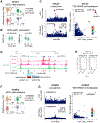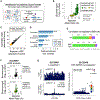TIGER: The gene expression regulatory variation landscape of human pancreatic islets
- PMID: 34644572
- PMCID: PMC8864863
- DOI: 10.1016/j.celrep.2021.109807
TIGER: The gene expression regulatory variation landscape of human pancreatic islets
Abstract
Genome-wide association studies (GWASs) identified hundreds of signals associated with type 2 diabetes (T2D). To gain insight into their underlying molecular mechanisms, we have created the translational human pancreatic islet genotype tissue-expression resource (TIGER), aggregating >500 human islet genomic datasets from five cohorts in the Horizon 2020 consortium T2DSystems. We impute genotypes using four reference panels and meta-analyze cohorts to improve the coverage of expression quantitative trait loci (eQTL) and develop a method to combine allele-specific expression across samples (cASE). We identify >1 million islet eQTLs, 53 of which colocalize with T2D signals. Among them, a low-frequency allele that reduces T2D risk by half increases CCND2 expression. We identify eight cASE colocalizations, among which we found a T2D-associated SLC30A8 variant. We make all data available through the TIGER portal (http://tiger.bsc.es), which represents a comprehensive human islet genomic data resource to elucidate how genetic variation affects islet function and translates into therapeutic insight and precision medicine for T2D.
Keywords: RNA-seq; allele-specific expression; beta cell; epigenomics; expression quantitative trait locus (eQTL); genome-wide association study (GWAS); pancreatic islets; regulatory variation; transcriptome; type 2 diabetes.
Copyright © 2021 The Authors. Published by Elsevier Inc. All rights reserved.
Conflict of interest statement
Declaration of interests A.L.G.’s spouse is an employee of Genentech and holds stock options in Roche.
Figures





References
-
- Abderrahmani A, Niederhauser G, Plaisance V, Roehrich ME, Lenain V, Coppola T, Regazzi R, and Waeber G (2004). Complexin I regulates glucose-induced secretion in pancreatic b-cells. J. Cell Sci 117, 2239–2247. - PubMed
-
- Akey JM, Biswas S, Leek JT, and Storey JD (2007). On the design and analysis of gene expression studies in human populations. Nat. Genet 39, 807–808, author reply 808–809. - PubMed
Publication types
MeSH terms
Substances
Grants and funding
LinkOut - more resources
Full Text Sources
Medical

